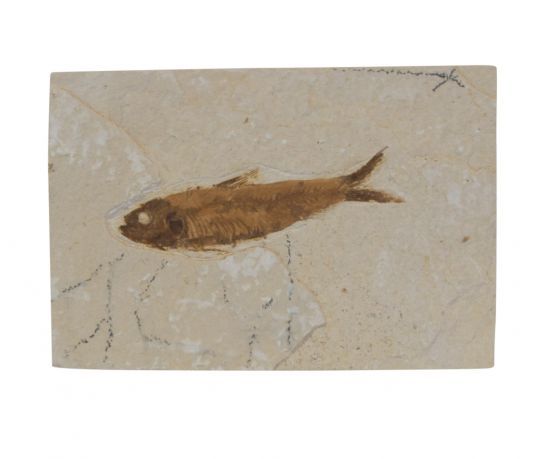We use cookies to make your experience better.
Fossil Fish (Knightia) from Kemmerer in Wyoming, U.S.A.
- Buy 10 for €18.50 each and save 16%
Knightia is an extinct genus of clupeid clupeiform bony fish that lived in the freshwater lakes and rivers of North America during the Eocene. The genus was founded by David Starr Jordan in 1907, in honor of the late University of Wyoming professor Wilbur Clinton Knight, "a tireless student of paleontology of the Rocky Mountains." It is the state fossil of Wyoming, and the most excavated fossil fish in the world.
By fossils is meant all the remains and traces of plants and animals that are preserved in rocks. Although that is often thought, fossils do not have to be 'petrified'. Very many fossils are indeed not petrified. Even from very old rocks fossil remains are known that have hardly changed. Furthermore, many think that fossils are always very old. This is also not justified. Many very young fossils are known, created in periods known to people. The science that studies fossils is called paleontology. This knowledge area helps with research into the succession of rocks, a branch within geology that is called biostratigraphy. Because remains of life only fossilize under specific circumstances, the fossil information is limited and by definition "incomplete". The word fossil often refers to the bones of dinosaurs or mammoths and it is true that the hard parts of an organism have the greatest chance of being preserved by fossilization. For vertebrates, those are the bones and especially the teeth. The softer tissues of the organism are only preserved in special cases and are therefore much rarer. Softer tissues are only preserved if they are quickly buried under a layer that shields them against any kind of rot or eater. With only the hard parts, it is sometimes difficult to form a good picture of the entire organism. A good example of this are the Conodonta, which were found in large numbers for a long time, but were only known for their teeth. Only when an impression of the rest of such an animal was also found, it turned out that this was a primitive form of the Chordata tribe. In other animal groups, other hard parts such as shells are often fossilized. There are a number of special forms of fossilization. In amber, for example, complete insects are sometimes found trapped, because the resin from which the amber is formed forms a good seal against oxidation. This also applies on a larger scale to tar pits. Near the American city of Los Angeles is a good example of this in the La Brea tar pits. Of animals that were trapped in the tar pit, the bones were often particularly well preserved. Moreover, the trapped animals often attracted predators, who also became entangled. In this way a "bone graveyard" was formed during the Pleistocene. Very well-preserved fossils are often found in clays deposited in still oxygen-free water. Due to the absence of oxygen, plants fossilize particularly well. Very often not the entire water column is oxygen-free but only the lower part. Such layered water therefore has a normal oxygen content in the top layer. In the upper layer, organisms die and then sink down and end up in an oxygen-free environment where they are preserved. Living organisms can also accidentally end up in the lower oxygen-free layer, causing them to die and fossilize. In such a deposit, fish are sometimes kept in a cramped manner, indicating suffocation. A well-known rock with such fossils is the 'Kupferschiefer' from the Rotliegend in central Germany. In addition to remains that originate from organisms themselves, traces that have been made active or passive by organisms are also counted as fossils. This includes, for example, coprolites (fossilized droppings) and spore fossils such as footprints and excavations. It is not always possible to identify the animal from spore fossils. They therefore often get their own taxonomic name.
| Dimensions | 110/130x80/100 |
|---|












